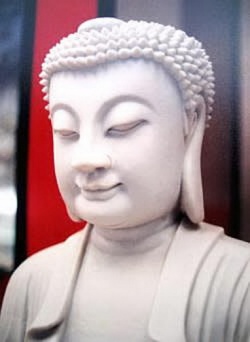Important Schools of Chinese Buddhism
The Pure Land School (Jingtu Zong 淨土宗, jap.: Jodo Shu, kor.: Chòngt'o Jong) that focuses on the simple Amitabha (chin.: Namo Amituofo 南無阿彌陀佛; jap.: Amida, kor.: Amit'a) cult, was already founded by Huiyuan 慧遠 during Eastern Jin, but the monk Shandao 善導 (d. 681) was its forming patriarch. Its basic writing is the Wuliangshou Jing 無量壽經 in a short and a long
version. Both decribe the Western Paradise, the access to which is possible by meritorious deeds as well as faith and devotion to the Amitabha Buddha. A central deity in Jingtu Buddhism is the Guanyin (jap.: Kan'on) Bodhisattva, the Chinese form of the Avalokiteshvara. Shandao wrote that five activities could lead to rebirth
in the Western Paradise: uttering the name of the Buddha (nian Fo 念佛), chanting the sutras, meditating on the Buddha, worshipping and singing praises to the Buddha. The Pure Land School is one of the most popular of Buddhist schools and has still many believers today. See an example of the Larger Amitabha Sutra.
The Tiantai School 天台宗 (Tiantai Zong, jap.: Tendai Shu, kor.: Ch'ontae Jong) was founded by Zhiyi 智顗 (d. 597), basing on the Lotus Sutra. According to Zhiyi, the Buddha taught different Sutras during his lifetime. Because the early sermons, were too complicated for the mass, the Buddha relied on simplier "Scriptures" (agama, chin.: ahan 阿含) to preach.
Later on, he preached the elementary vaipulya "broad and equal" (chin.: fangdeng 方等) sutras of the Great Vehicle, to end with the "Sutra of Perfection of Wisdom" (Prajnaparamita-sutra) and the Nirvana and Lotus Sutras. A central teaching of the Tiantai school is the Threefold Truth (santi 三諦): voidness of all things, temporariness of
all phenomena, and the synthesis of emptiness and phenomenal existence as the truth of the mean or middle. The absolute mind embraces the universe in its entirety, small and huge things. To separate one's consciousness from worldy phenomena (dharma), spiritual concentration and insight consiousness help to become aware of the non-existance of all appearance and that all is a manifestation of the absolute mind. The Buddha nature can even be found in inanimate things.
Fazang 法藏 (d. 712) founded the Garland School (Huayan,, jap. Kegon, kor.: Hwaòm) 華嚴宗, basing on the Garland Sutra 華嚴經. The empty phenomena are thought to arose simultaneously by themselves. The static principle (li 理) and the dynamic phenomenon (shi 事; things and their appearance) of the emptiness are interfused and mutually identified. No phenomenon can exist independently and alone, all things depend on others and are combined to a whole. This system of totality finally points to the Buddha in the center.
A very special school that renounced dogma, asceticism, rites and the traditional monastery system, was the Chan School 禪宗 (Chan Zong, jap.: Zen Shu, kor.: Jòn Jong; a term deriving from the Sanskrit word dhyâna "meditation, yoga"), founded by Bodhidharma (chin.: Putidamo 菩提達摩; d. 524) and Huineng 慧能 (d. 713; see an excerpt from his writing "
Altar Sutra" Tanjing). The believers of Chan relied on riddles (gongan 公案) and spontaneous actions to achieve enlightenment. Because of the emptiness (shunyata; chin.: kong 空) of reality, the Buddha nature can only be apprehended by intuition. Avoiding conscious thought, reality is expressed by silence or negation of the object in
mind. It was the Chan School that also developed the worldwide known fighting techniques (gongfu 功夫, "Kung-fu") in the Shaolin Monastery 少林寺. The spontaneity thought of Chan Buddhism is familiar to Taoism and the nature-near spontaneous action of the free individual. Chan monks also composed writings like the "Green Cliff Records" Biyan Lu 碧巖録, and the "Gateless Pass" Wumenguan 無門關.
Important branches of the Chan School are the Caodong School 曹洞宗, Linji School 臨濟宗.
The Idealistic School (Faxiang Zong 法相宗) was founded by the great pilgrim Xuanzang 玄奘 (d. 664) and based on the Mahayana-samgraha "Compendium of the Great Vehicle" and the Yogacarin writings. According to the idealistic teachings, the external world is but a fabrication of our consciousness and does not really exist and is only an illusion. The five sensual consiousnesses like sight, hearing, and so on, are helped by the conscious mind, which forms conceptions out of the perceptions received from outside. A seventh consciousness is the thought center, and finally the storehouse consciousness, which stores and coordinates all the ideas reflected in the mind. This school did not survive the great persecutions of 845 AD.
Very little impact on the history of Chinese Buddhism had the Sattyasiddhi School (Chengshi Zong 成實宗) that was originally a Theravada school but was oriented to Mahayana by its explanation that Buddhahood can be attained by destroying the attachment to names, elements and emptiness. Its main writing is the Sattyasiddhi-Shastra.
The School of the Middle Path (Zhongdao Zong 中道宗 or Zhongguan Pai 中觀派), is the Chinese branch of the Indian Madhyamika School that seeks a middle way between two extremes like existence and non-existence, between emptiness and non-emptiness. The most important representants of this school were Buddhapalita (chin. Fohuo佛護; d.540) and Candrakirti (chin. Yuecheng 月稱, d. 650).
A branch of the Madhyamika School is the Three Treatise School (Sanlun Zong 三論宗). The most important representant is Jizang 吉蔵 whose thought bases upon the three treatises Zhong Lun 中論, Shiermen Lun 十二門論, and Bai Lun 百論, all writings that deeply influenced the Chinese Tiantai and Huayan Schools.
Less important are the two vinaya schools Jielü Zong 戒律宗 and Nanshan Zong 南山宗, the Nirvana School (Niepan Zong 涅槃宗), and the School of Consciousness (Weishi Zong 唯識宗).
